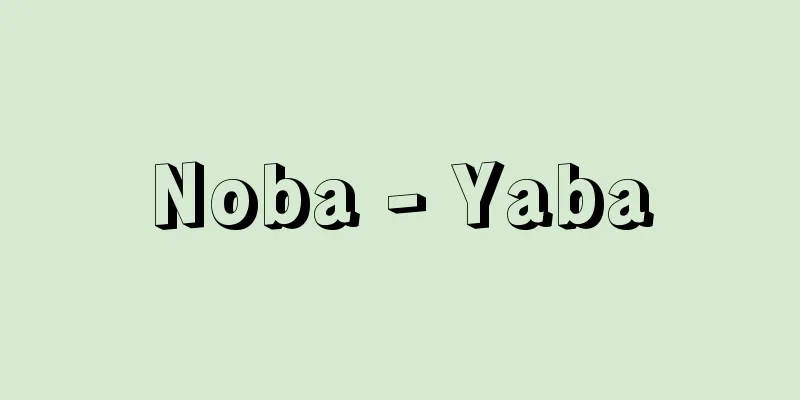Extremely low temperature

|
Extremely low temperature range. In physics, it refers to a temperature range that is sufficiently low compared to room temperature and relatively close to absolute zero. However, with the advancement of physics, the lowest temperature in this temperature range has dropped dramatically, and in 1981, the success of nuclear adiabatic demagnetization made it possible to reach an absolute temperature of around 20 microK (1 microK is one millionth of a degree K). Furthermore, in 1995, the Joint Institute for Laboratory Astrophysics ( JILA ), jointly operated by the University of Colorado and the National Institute of Standards and Technology in the United States, achieved a temperature of 20 nanoK (1 nanoK is one billionth of a degree K) by laser cooling the alkali metal rubidium-87 (87 Rb). As a result, the term "ultra-low temperature" was also used in low temperature physics. [Taka Watanabe] Where does the cryogenic temperature range begin?In modern physics, the cryogenic region should be understood to mean the temperature range below 0.1K (absolute temperature). This is because the method of generating low temperatures is different in regions below this temperature boundary, and there are certain difficulties in taking into account factors such as heat inflow, even when performing physical measurements with high precision. However, physical measurements in this range have come to be performed with a fairly high degree of precision down to 1/100 K, just as they can be performed above 1 K, and currently physical measurements in the temperature range of around 1 milliK (1/1000 K) can be performed relatively easily. One reason for this is the commercialization of dilution refrigerators with high refrigeration capacity that utilize the quantum effect of the isotopes helium-3 ( 3He ) and helium-4 ( 4He ), and another is the development of electronics, centered around the development of the SQUID, a measuring element that uses the quantum interference effect. Nuclear adiabatic demagnetization has made it possible to reach temperatures around 10 microK, and developments in this field of low temperature physics have revealed the physical properties of materials below 1 milliK. As a result, temperatures below 1 milliK have come to be called "ultra-low temperatures." Developments are currently underway in magnetic levitation trains, superconducting generators and motors, superconducting power transmission, and very large superconducting electromagnets for high-energy accelerators, MHD power generation (magnetic hydrodynamic power generation), and future nuclear fusion reactions. [Taka Watanabe] Developments in refrigeration and cryogenicsUnlike the cryogenic temperatures in physics, temperatures that are considered to be significantly lower than the room temperature of about 20°C where humans live, such as the temperature of liquid nitrogen, are sometimes called cryogenic or ultra-low temperatures. This is because they have been considered the limit temperature from the perspective of freezing technology in engineering. The temperature inside the freezer of an electric refrigerator that uses fluorocarbon gas as a refrigerant is approximately -15 to -25°C. This was the temperature range for frozen storage until around 1960. Even lower temperatures could only be reached at -77°C by using dry ice for special purposes. However, during the period of rapid economic growth from 1960 onwards, it became possible to use large amounts of liquid nitrogen as a refrigerant. The boiling point of liquid nitrogen is 78K (-195°C) at 1 atmosphere. Freezing and preserving frozen foods using liquid nitrogen is effective in preventing the deterioration of quality due to oxidation. For this reason, it has spread rapidly since the 1960s, leading to the formation of the current cold chain as a distribution channel for frozen foods. Liquid nitrogen is also widely used to preserve medicines, blood, plasma, and serum. In the field of surgery, cryo-anesthesia using liquid nitrogen is also used for ultra-low temperature surgery for cancer, polyps, and other such surgeries. When an unprecedented range of low temperatures is developed, the new low temperature range is sometimes called extremely low temperature or ultra-low temperature in the fields of technology and engineering. The rapid development of the cold chain was driven by the mass consumption of oxygen in steelworks due to the oxygen steelmaking process that became widespread in the late 1950s. [Taka Watanabe] "The Quantum World - Physics of Cryogenic Temperatures" by Nakajima Sadao (1975, University of Tokyo Press)" ▽ "Low Temperatures - The Road to Absolute Zero" by Haseda Taiichiro and Mekata Mamoru (1975, NHK Books)" ▽ "Cryogenic Temperatures and Superconductivity - Gas Liquefaction Processes and Applied Technology" by Nagano Hiroshi (1986, Keigaku Publishing)" ▽ "From Superfluidity to Superconductivity" by Watanabe Takashi (1991, Otsuki Shoten)" ▽ "Cryogenic Technology in Extreme Science" by Moriya Junichiro (1992, Tokyo Denki University Press)" ▽ "A Story of Cryogenic Temperatures" by Ogihara Hiroyasu and Nakagomi Hideki (1994, Ohmsha)" ▽ "Cryogenic Metal Processing" by Kobayashi Masaru (1998, Nikkan Kogyo Shimbun)" ▽ "Handbook of Technology Utilizing Low Temperature Environments - Technology Utilizing Low, Ultra Low, and Extreme Low Temperatures" edited by Nobuhiro Seki (2001, Morikita Publishing) " "The World of Extremely Low Temperatures - Visible Quantum Phenomena" by Takashi Watanabe (Shinnihon Shuppansha, Shinnihon Shinsho) [References] | | | | | | | | |©Shogakukan "> Boiling and melting points of cryogenic liquids for refrigeration at 1 atmosphere Source: Shogakukan Encyclopedia Nipponica About Encyclopedia Nipponica Information | Legend |
|
きわめて低い温度領域。すなわち物理学において、室温から比べると十分に低い、いわゆる絶対零度に比較的近い温度領域をさす。しかし、この温度領域は、物理学の進歩とともに、最低到達温度が飛躍的に低下し、1981年には核断熱消磁の成功によって、絶対温度で20マイクロK(1マイクロKは100万分の1K)付近に到達できるようになった。さらに1995年、アルカリ金属であるルビジウム87(87Rb)のレーザー冷却により20ナノK(1ナノKは10億分の1K)が、アメリカのコロラド大学と国立標準技術研究所が共同運営する宇宙物理学複合研究所(JILA=Joint Institute for Laboratory Astrophysics)によって実現された。そこで、新たに「超低温」なることばも低温物理学のなかで用いられるようになった。 [渡辺 昂] どこからが極低温領域か?現在の物理学においては、極低温領域とは、0.1K(絶対温度)以下の温度領域をさすと理解するのが適当である。なぜならば、この温度を境として、より低温の領域では低温の生成法も異なり、物理測定を高い精度で行うことについても、熱の流入などを考慮するとき一定の困難があったからである。 しかし、この領域における物理測定は、100分の1Kまでは、1K以上におけるのと同様に、かなり高い精度で行われるようになり、現在では、1ミリK(1000分の1K)前後の温度領域の物理測定が比較的容易に行われている。それは、一つは同位元素(アイソトープ)であるヘリウム3(3He)とヘリウム4(4He)の量子効果を利用した希釈冷凍器の冷凍能力の大きな装置が商品化されたこと、もう一つは、量子干渉効果を用いた測定素子SQUIDの開発を中心としたエレクトロニクスの発達による。 核断熱消磁法によって10マイクロK付近への到達が可能となり、低温物理学のこの分野の発展によって1ミリK以下における物質の物理学的性質が解明されてきた。その結果1ミリK付近からさらに低温の領域を「超低温」とよぶようになった。磁気浮上式鉄道、超伝導発電機および電動機の開発、超伝導電力送電の開発、高エネルギー加速器用・MHD発電(磁気流体発電)用・または未来の核融合反応用の超大型の超伝導電磁石などの開発が、現在も進められている。 [渡辺 昂] 冷凍技術と極低温工学の発達物理学でいう極低温とは異なり、人間が生活する室温である約20℃に比較してかなり低いと考えられる温度、たとえば液体窒素の温度付近を極低温ないしは超低温ということがある。これは工学における冷凍技術からみた極限温度と考えられてきたからである。 フロンガスを冷媒とした電気冷蔵庫のフリーザー(冷凍庫)内の温度は、おおよそ零下15~25℃である。1960年ころまでの冷凍保存とはこの温度領域であった。さらに低い温度といっても、特殊な目的のためにドライアイスを用いて零下77℃に到達するのが限度であった。ところが1960年以降の経済の高度成長期を通じて、冷媒として液体窒素の大量使用が可能になってきた。液体窒素の沸点は1気圧の下で78K(零下195℃)である。 液体窒素を用いた冷凍保存は、冷凍食品の酸化による品質の低下を防ぐために有効である。このために、1960年以降急速に普及し、冷凍食品の流通経路として現在のコールド・チェーンを形成するに至った。このほかに、医薬品の保存、血液・血漿(けっしょう)・血清(けっせい)の保存にも液体窒素は広く使用されている。また外科医学の分野においても、癌(がん)、ポリープなどの手術に、液体窒素を用いた冷凍麻酔による超低温外科手術も行われている。このようにこれまでにない低温の領域を開発したときに、技術、工学の分野でもその新たな低温領域に極低温、超低温の名を冠してよばれることがある。なお、コールド・チェーンの急速な発達を促したのは、1950年代後半より普及した酸素製鋼法による製鉄所における酸素の大量消費であった。 [渡辺 昂] 『中嶋貞雄著『量子の世界――極低温の物理』(1975・東京大学出版会)』▽『長谷田泰一郎・目片守著『低温――絶対零度への道』(1975・NHKブックス)』▽『永野弘著『極低温と超電導――気体液化のプロセスと応用技術』(1986・啓学出版)』▽『渡辺昂著『超流動から超伝導へ』(1991・大月書店)』▽『守屋潤一郎著『極限科学のなかの極低温技術』(1992・東京電機大学出版局)』▽『荻原宏康・中込秀樹著『極低温のはなし』(1994・オーム社)』▽『小林勝著『極低温金属加工』(1998・日刊工業新聞社)』▽『関信弘編『低温環境利用技術ハンドブック――低温・超低温・極低温を活かす技術』(2001・森北出版)』▽『渡辺昂著『極低温の世界――目に見える量子現象』(新日本出版社・新日本新書)』 [参照項目] | | | | | | | | |©Shogakukan"> 冷媒用低温液体の1気圧下での沸点と融点 出典 小学館 日本大百科全書(ニッポニカ)日本大百科全書(ニッポニカ)について 情報 | 凡例 |
Recommend
Yoshitada Ashikaga
⇒ Ashikaga Yoshitane Source: Kodansha Digital Japa...
Proverbs - Proverbs
It is one of the typical linguistic expressions th...
Aculops pelekassi (English spelling) Aculopspelekassi
…Eriophyid mites are also carriers of plant virus...
New Confucianism
...When historical and social developments threat...
Penetrating bullet wound
…Generally, it is called a gunshot wound. (1) Typ...
Dictionary of Music and Musicians
…He studied classical and romantic composers, and...
Foreign Affairs Bureau - gaikokujimukyoku
〘Noun〙 One of the eight bureaus established by the...
Bosmina longirostris
Class: Branchiopods, Order: Bivalva, Family: Bosmi...
Forsythia viridissima (English spelling) Forsythiaviridissima
… [Mitsuru Hotta]... *Some of the terminology tha...
Myokakuji Temple
[1] A Nichiren sect temple in Okitsu, Katsuura Cit...
neighbouring rights
...The rights granted to performers, phonogram pr...
Kasai Bayashi
This is a festival music tradition that is passed...
Bernoulli's theorem
For a perfect fluid with negligible viscosity, wh...
Mothers' Conference - Hahaoya Taikai
The purpose of this conference is to discuss vario...
Ishikawajima Heavy Industries Co., Ltd.
...The company is expanding its plant, resource, ...









![Orkney [Islands] - Orkney](/upload/images/67cb1bb298e2c.webp)